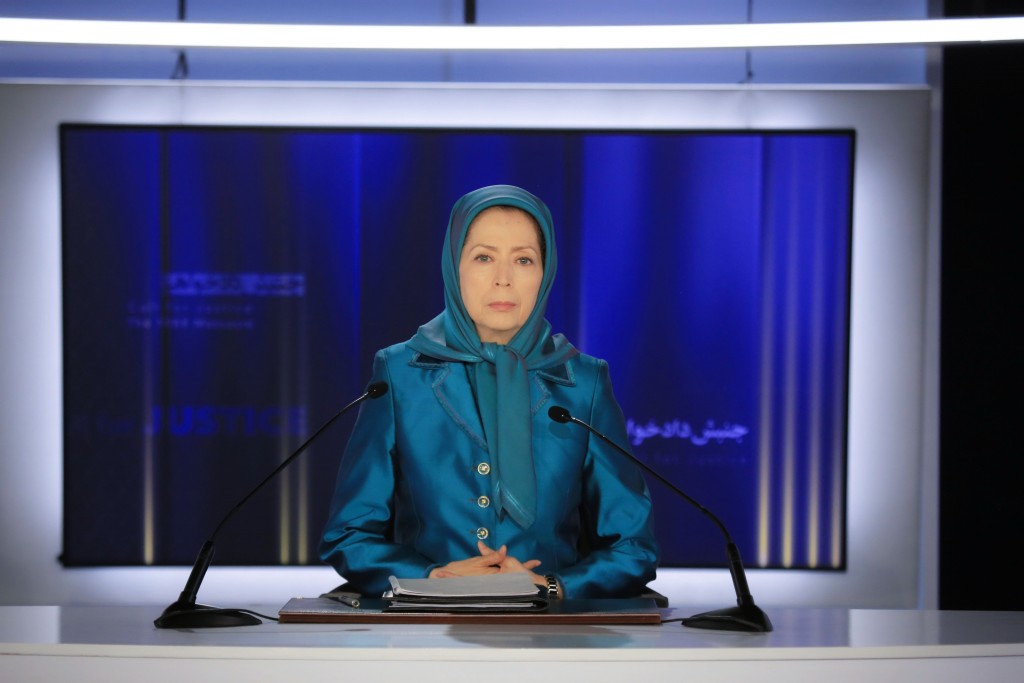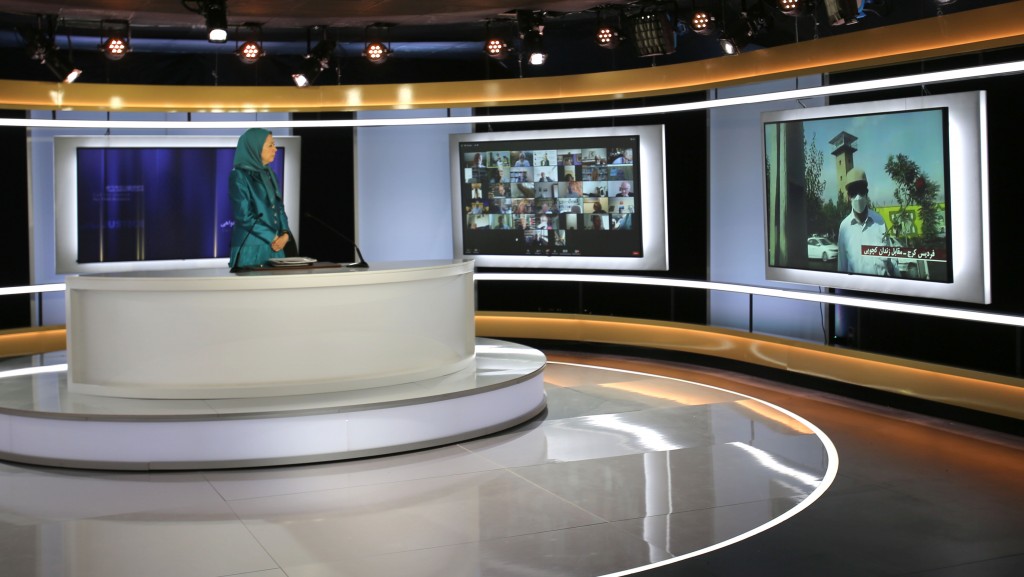The Call-for-Justice movement is to overthrow the clerical regime

International virtual conference with 1,000 former political prisoners in attendance
Iran: 1988 Massacre and Genocide
No to Impunity, Yes to Accountability
In a conference coinciding with the 30th anniversary of the 1988 massacre, more than 1,000 political prisoners and witnesses of torture in prisons and dungeons of the clerical regime demanded an end to the impunity enjoyed by the regime leaders and to prosecute Khamenei, Raisi, Judiciary Chief, Eje’i and other perpetrators of the massacre. During the 1988 massacre, based on Khomeini’s fatwa, the clerical regime executed at least 30,000 political prisoners, more than 90% of whom were Mujahedin-e Khalq (MEK/PMOI) activists. They were massacred for their steadfast commitment to MEK’s ideals and the Iranian people’s freedom.
Maryam Rajavi, and hundreds of prominent political figures, as well as jurists and leading experts on human rights and international law from around the world, participated in the conference. Some of the speakers of the conference included Guy Verhofstadt, Prime Minister of Belgium (1999-2008), Franco Frattini, Minister of Foreign Affairs of Italy (2008-2011), Giulio Maria Terzi, Italian Foreign Minister (2011-2013), John Baird, Canada’s Minister of Foreign Affairs ( 2011-2015), Audronius Ažubalis, Minister of Foreign Affairs of Lithuania (2010-2012), Kumi Naidoo, Secretary-General of Amnesty International (2018-2020), Dominique Atias, President of European Bars Federation from March 2021, Geoffrey Robertson, the first president of the UN Special Court for War Crimes in Sierra Leone, Eric David, Professor of International Law, Valeriu M. Ciuca, former judge of the European Court, and Gulnara Shahinian, the UN Special Rapporteur on Contemporary Forms of Slavery (2008-2014).
Maryam Rajavi said:
Dear Friends,
Sisters and brothers,
Greetings to you and the distinguished political dignitaries, jurists, parliamentarians, and human rights advocates attending this conference!
Thirty-three years ago, in the summer of 1988, Khomeini issued a fatwa (a religious decree) to execute all imprisoned members of the People’s Mojahedin Organization of Iran (PMOI/MEK), who remained steadfast. Some 30,000 political prisoners, 90% of whom were PMOI members, were subsequently executed. The mass killing quickly spread to other prisoners.
August 27 is a reminder of the day 33 years ago when, according to numerous documents and reports, the executions of Marxist and Kurdish combatants, including members of the Kurdistan Democratic Party of Iran, Komeleh, and the Khabat Organization of Iranian Kurdistan, began. We pay tribute to everyone who laid down their lives for Iran’s freedom, many of them still unknown.
Prisoners surviving the 1988 massacre
Nevertheless, today, we see an extraordinary gathering with no precedent in the history of people’s struggles for human rights and the call for justice for the blood unjustly shed.
Some 1,000 political prisoners tortured under the dictatorships of the mullahs and Shah are attending today’s gathering from Ashraf-3; approximately a quarter of them are women.
We also have many former political prisoners joining us from various countries.
Many of them were first-hand witnesses to the countless executions in the 1980s and the massacre of political prisoners in 1988. They are the survivors of a bloody and widespread crackdown with 120,000 victims.
The clerical regime wanted to break and defeat every member and supporter of the PMOI/MEK by torturing, burning, and flogging. It tried all evil, malicious, and inhuman tactics.
They inflicted the most depraved tortures on the female PMOI/MEK prisoners in the so-called “residential units.” They locked them in “cages” for weeks and months to break their spirit of resistance.
Finally, in the summer of 1988, PMOI members were offered a choice between death or submission coupled with renouncing their loyalty to the PMOI/MEK.
However, the generation that stepped into this path inspired by Massoud Rajavi and longing for freedom resisted heroically in prisons, under torture, and in the harshest conditions. Even when they had to choose between surrender and execution, they courageously adhered to their principles: the overthrow of the clerical regime and the establishment of freedom for the people.
The courageous PMOI/MEK prisoners and other brave activists proved that their resistance, even with hands tied and in dark and damp cells, was part of the campaign to overthrow the regime. In this struggle, the executioner bowed to the prisoners’ resolve and determination.
Some of those former political prisoners later laid down their lives in the operations of the National Liberation Army of Iran or during the clerical regime’s missile and rocket attacks on Camps Ashraf and Liberty.
They include Zohreh Ghaemi, imprisoned for five years; Pouran Najafi, who wrote her memoirs of five years of captivity in a book entitled “The Flight of the Enchained;” Hossein Sarv Azad, a witness to the 1988 massacre, and Alireza Taherlou, both of them incarcerated for 10 years. They had committed no crime but persevering in the cause of freedom and the PMOI’s ideals.
The regime’s goal is to obliterate a generation and an ideology
For years, despite absolute repression, the Iranian Resistance provided the international community with documents of brutal torture in the regime’s prisons. Former political prisoners with limbs bruised by the continuous beating of cables frequently testified in international forums.
From the onset of the 1988 massacre, the Iranian Resistance provided information about the mass executions to the United Nations. Unfortunately, they chose to turn a blind eye to these crimes.
A few months ago, seven UN special rapporteurs reported that the United Nation’s inaction over the 1988 massacre had emboldened the Iranian regime and worsened the human rights situation in Iran.
The 1988 massacre is a clear example of genocide. Khomeini’s fatwa was an explicit decree to execute all the Mojahedin who remained steadfast.
Earlier, in 1980, Khomeini’s religious judge in the city of Bam [in the southern province of Kerman] had written in a decree that on Khomeini’s order, “[The PMOI/MEK] members have neither property rights nor the right to life.”
In January 2010, Ebrahim Raisi, the regime’s current president, declared that “All Mojahedin are enemies of God and punishable by death.”
Mullah Ahmad Jannati, the chairman of the Guardians’ Council, also clearly stated: “[the People’s Mojahedin] must be uprooted so that the regime could strengthen its roots.”
Mostafa Pourmohammadi, a member of the Death Commission, said two years ago in August 2019: “We have not yet settled our score with the PMOI/MEK. The time has come to do so. Today, the hypocrites [a pejorative term the regime uses to refer to the Mojahedin] are our most treacherous enemy… and they must answer; they must appear in court. We must punish them one by one.”
Thus, the goal of the regime goes far beyond the execution of several thousand; it is the obliteration of a generation, an ideology, and men and women who rejected religious extremism under the guise of Islam and stood up for human freedom and dignity.
Although these men and women had faith in Islam, they adhered to the separation of religion and state, believing in freedom and equality for all, regardless of ethnicity, ideology, or religion, and sacrificed everything. This commitment embodies the visage and history of the PMOI over the past 56 years.
For the most part, the stories of the perseverance of PMOI prisoners who audaciously maintained their positions in face-to-face encounters with the Death Commissions’ executioners have remained untold.
Therefore, the gathering of 1,000 PMOI/MEK prisoners is a unique capital for the Call-for-Justice movement and the Resistance movement that seeks to overthrow the regime.
The fact that such a large and valuable group of witnesses to the regime’s crimes are at the core of a revolutionary movement speaks volumes about a tremendous social reality. Over the past 33 years, they have continuously contributed to the Call-for-Justice Movement with their high spirit and effective presence in the struggle against religious fascism.
This extraordinary assembly is the tip of a great pyramid in Iranian society that consists of hundreds of thousands of tortured prisoners and families of 120,000 martyrs to the cause of freedom.
Together with their comrades-in-arms in Ashraf-3, they have amassed more than 100,000 years of experience in full-time resistance within the PMOI. They form the beating heart of the Iranian people’s organized nationwide resistance, which on the one hand, has been the most crucial factor in undermining the regime over the decades and, on the other hand, has guaranteed the regime’s overthrow and the establishment of a free and democratic future for Iran.
This large political and social group is a constant reminder that a sea of blood separates Iranian society from the ruling regime, the most critical factor stripping the regime of its legitimacy.
In this way, we see the two fronts arrayed against one another and separated by an ocean of blood.
According to Massoud Rajavi, the Leader of the Iranian Resistance, since June 20, 1981, there are only two camps: The camp consisting of the people and their Resistance for freedom versus the camp consisting of reactionaries, tyrants, and mass murderers, whose president is the henchman of the 1988 massacre. His presidency is an open declaration of war on the people of Iran and the PMOI/MEK, which is at the heart of the Iranian people’s army of freedom.

The powerful Call-for-Justice Movement
The Call-for-Justice Movement, with its endless line of combatants and martyrs, is not a spontaneous phenomenon.
In September 1988, the Leader of the Iranian Resistance wrote to the UN Secretary-General: “According to reliable information, a few weeks ago, in a decree in his handwriting Khomeini ordered the execution of the PMOI political prisoners.”
This powerful movement has progressed over the past three decades with thousands of revelations, the publication of numerous books and pamphlets, thousands of demonstrations, rallies, exhibitions, sit-ins, investigations, and judicial inquiries while holding people’s tribunals in which witnesses testified about the massacre.
These days, the rallies and demonstrations of freedom-loving Iranians and supporters of the Iranian Resistance outside a Stockholm court are yet another glorious feature of the Call-for-Justice Movement.
With such determination to fight, Khamenei cannot evade drinking the poisonous chalice of human rights.
I pay tribute to all of you, sisters and brothers, present in this assembly. I hail all the supporters and activists of the Call-for-Justice Movement inside Iran and abroad.
Erasing the identity of the victims of the 1988 massacre
For us, the Call-for-Justice movement is synonymous with perseverance, steadfastness, and resistance to overthrow this regime and establish freedom with all our strength. For this reason, denying the massacre, minimizing the number of victims, and erasing their identities are what the regime is seeking, because they serve its interests and ultimately help preserve its rule.
Concealing the names and destroying the graves of the victims serve the same purpose.
In a letter to Hossein Ali Montazeri, his deposed successor, Khomeini criticized him, saying that “the Hypocrites [the PMOI/MEK] used your remarks and writings to put the number of those executed at thousands.”(1)
The discussion about erasing the identity of the victims of the massacre is not a partisan issue. It is the core of the issue and the critical step to undermine the principles and positions those martyrs laid down their lives for and walked to the gallows.
These martyrs were steadfast in chanting, “Down with Khomeini, long live freedom and hail to Massoud Rajavi.” The same position that all the PMOI/MEK members insist on and maintain today.
How can one seek to destroy the PMOI/MEK, crush their positions, values, and red-lines, eliminate the Resistance’s Leader, and call himself a sympathizer of the martyrs and seek justice for them?
This is the ploy of the mullahs’ intelligence services and the IRGC to distort and divert the Call-for-Justice Movement and undermine it.
More than 100 political prisoners of the Shah’s era, who are among the greatest assets of the Iranian nation’s struggle, along with 1,500 former political prisoners of the mullahs’ era, have experienced and exposed the ploys of the Shah’s SAVAK and the mullahs’ VEVAK. They are no longer fooling anyone, especially since our people are still mourning the killing of at least 1,500 youths during the November 2019 uprising by the Revolutionary Guards and intelligence agents, and are furious and upset about the deaths of some 400,000 compatriots due to the coronavirus. Khamenei’s criminal role in opposing the purchase of vaccines is common knowledge.
On the other hand, everyone knows that from the very beginning, the Iranian Resistance denounced the strategy of mass casualties and human shields by sending people into the minefields of coronavirus to protect the regime from the danger of uprisings and being overthrown. It is similar to the strategy of mass casualties in the unpatriotic war against Iraq and the massacre of political prisoners to preserve the faltering regime.
Supporters of the Iranian Resistance,
Courageous men and women who reiterated the commitment to the resistance at any cost,
When the Shah was torturing and murdering prisoners behind the high prison walls or on the hills of Evin, he never imagined that the storm of uprisings was approaching that would sweep away his regime with the cries of “free all political prisoners.”
Khomeini, Khamenei, and their accomplices, who ordered the hanging of thousands upon thousands of prisoners by executioners like Ebrahim Raisi, did not think that one day a powerful movement would rise against the religious dictatorship to seek justice for victims from 1988 to November 2019.
An international mission to investigate the 1988 massacre
At this point, I would like to salute all the personalities and human rights advocates who have stepped forward to defend the victims of the 1988 massacre on the international level. I particularly salute my brother, Tahar Boumedra, former director of the human rights office of the UNAMI in Iraq and the current director of the Justice for the Victims of the 1988 Massacre in Iran (JVMI), as well as the prominent jurists who have attended this conference. The efforts and initiatives of these noble human beings are a valuable service to humanity and its future.
Today, there is an international consensus calling on the United Nations High Commissioner for Human Rights and the Human Rights Council to establish an international fact-finding mission to investigate the 1988 massacre in Iran.
This is the demand of the UN Special Rapporteur on the situation of human rights in Iran, Amnesty International, and more than 150 prominent human rights advocates.
I again call on the U.S. and Europe to recognize the 1988 massacre in Iran as genocide and a crime against humanity. They must not accept Raisi in their countries. They must prosecute and hold him accountable.
I also reiterate my call to the UN Secretary-General, the UN High Commissioner for Human Rights, the UN Human Rights Council, the UN special rapporteurs, and international human rights organizations to visit the Iranian regime’s prisons and meet with the prisoners there, especially the political prisoners.
The dossier of human rights violations in Iran, especially regarding the regime’s conduct in prisons, should be submitted to the UN Security Council.
The eighth anniversary of the massacre in Ashraf
In five days, we will be marking the eighth anniversary of the massacre in Ashraf on September 1, 2013. On that day, the terrorist Qods Force led by Qassem Soleimani carried out the mass executions of 52 PMOI members and took seven hostages, whose fate is still unknown.
The PMOI members gave their lives in Camps Ashraf and Liberty, but they sowed the seeds of a thousand Ashrafs and a thousand resistance units across Iran. They stand as beacons of freedom for our people and our homeland.
The shining sun of Iran’s freedom is coming out from behind the dark clouds.
The Iranian Resistance is committed to turning these sacrifices into a force for the liberation of Iran and the triumph of their cause. This will be done!
Hail to the martyrs!
Long live freedom
Thank you all very much


